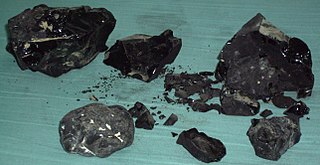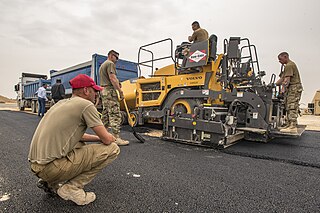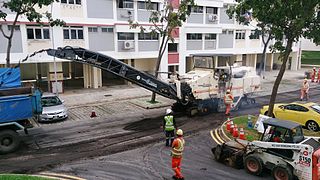
Bitumen is an immensely viscous constituent of petroleum. Depending on its exact composition it can be a sticky, black liquid or an apparently solid mass that behaves as a liquid over very large time scales. In the U.S., the material is commonly referred to as asphalt. Whether found in natural deposits or refined from petroleum, the substance is classed as a pitch. Prior to the 20th century the term asphaltum was in general use. The word derives from the ancient Greek ἄσφαλτος ásphaltos, which referred to natural bitumen or pitch. The largest natural deposit of bitumen in the world is the Pitch Lake of southwest Trinidad, which is estimated to contain 10 million tons.

Road transport or road transportation is a type of transport using roads. Transport on roads can be roughly grouped into the transportation of goods and transportation of people. In many countries licensing requirements and safety regulations ensure a separation of the two industries. Movement along roads may be by bike, automobile, bus, truck, or by animal such as horse or oxen. Standard networks of roads were adopted by Romans, Persians, Aztec, and other early empires, and may be regarded as a feature of empires. Cargo may be transported by trucking companies, while passengers may be transported via mass transit. Commonly defined features of modern roads include defined lanes and signage. Various classes of road exist, from two-lane local roads with at-grade intersections to controlled-access highways with all cross traffic grade-separated.

A road surface or pavement is the durable surface material laid down on an area intended to sustain vehicular or foot traffic, such as a road or walkway. In the past, gravel road surfaces, macadam, hoggin, cobblestone and granite setts were extensively used, but these have mostly been replaced by asphalt or concrete laid on a compacted base course. Asphalt mixtures have been used in pavement construction since the beginning of the 20th century and are of two types: metalled (hard-surfaced) and unmetalled roads. Metalled roadways are made to sustain vehicular load and so are usually made on frequently used roads. Unmetalled roads, also known as gravel roads or dirt roads, are rough and can sustain less weight. Road surfaces are frequently marked to guide traffic.

Asphalt concrete is a composite material commonly used to surface roads, parking lots, airports, and the core of embankment dams. Asphalt mixtures have been used in pavement construction since the beginning of the twentieth century. It consists of mineral aggregate bound together with bitumen, laid in layers, and compacted.

The free floating screed is a device pioneered in the 1930s that revolutionized the asphalt paving process. The device is designed to spread and smooth out, or screed, the material below it.

A loader is a heavy equipment machine used in construction to move or load materials such as soil, rock, sand, demolition debris, etc. into or onto another type of machinery.

Heavy equipment, heavy machinery, earthmovers, construction vehicles, or construction equipment, refers to heavy-duty vehicles specially designed to execute construction tasks, most frequently involving earthwork operations or other large construction tasks. Heavy equipment usually comprises five equipment systems: the implement, traction, structure, power train, and control/information.

Permeable paving surfaces are made of either a porous material that enables stormwater to flow through it or nonporous blocks spaced so that water can flow between the gaps. Permeable paving can also include a variety of surfacing techniques for roads, parking lots, and pedestrian walkways. Permeable pavement surfaces may be composed of; pervious concrete, porous asphalt, paving stones, or interlocking pavers. Unlike traditional impervious paving materials such as concrete and asphalt, permeable paving systems allow stormwater to percolate and infiltrate through the pavement and into the aggregate layers and/or soil below. In addition to reducing surface runoff, permeable paving systems can trap suspended solids, thereby filtering pollutants from stormwater.

A paver is a paving stone, tile, brick or brick-like piece of concrete commonly used as exterior flooring. They are generally placed on top of a foundation which is made of layers of compacted stone and sand. The pavers are placed in the desired pattern and the space between pavers is then filled with a polymeric sand. No actual adhesive or retaining method is used other than the weight of the paver itself except edging. Pavers can be used to make roads, driveways, patios, walkways and other outdoor platforms.

A curb, or kerb, is the edge where a raised sidewalk or road median/central reservation meets a street or other roadway.

Mighty Machines is a Canadian educational children's television series that teaches about machines and how they work. The show premiered in 1994 airing 39 episodes over three seasons until 2008.

A screw conveyor or auger conveyor is a mechanism that uses a rotating helical screw blade, called a "flighting", usually within a tube, to move liquid or granular materials. They are used in many bulk handling industries. Screw conveyors in modern industry are often used horizontally or at a slight incline as an efficient way to move semi-solid materials, including food waste, wood chips, aggregates, cereal grains, animal feed, boiler ash, meat, bone meal, municipal solid waste, and many others. The first type of screw conveyor was the Archimedes' screw, used since ancient times to pump irrigation water.

Screed has three meanings in building construction:
- A flat board or a purpose-made aluminium tool used to smooth and to "true" materials like concrete, stucco and plaster after they have been placed on a surface or to assist in flattening;
- A strip of plaster or wood applied to a surface to act as a guide for a screed tool ;
- The material itself which has been flattened with a screed. In the UK, screed has also come to describe a thin, top layer of material, poured in situ on top of the structural concrete or insulation, on top of which other finishing materials can be applied, or the structural material can be left bare to achieve a raw effect.

Blaw-Knox is a manufacturer of road paving equipment. The company was created in 1917 from the merger of Blaw Collapsible Steel Centering Company and the Knox Pressed and Welded Steel Company. Blaw-Knox was sold to new owners in 1968, changed owners a few times thereafter, and continues as the Volvo Blaw-Knox brand of paving equipment, sold to Volvo Construction Equipment since 2007. Since July 2020 it is owned by Gencor Industries Inc.

A concrete plant, also known as a batch plant or batching plant or a concrete batching plant, is equipment that combines various ingredients to form concrete. Some of these inputs include water, air, admixtures, sand, aggregate, fly ash, silica fume, slag, and cement. A concrete plant can have a variety of parts and accessories, including: mixers, cement batchers, aggregate batchers, conveyors, radial stackers, aggregate bins, cement bins, heaters, chillers, cement silos, batch plant controls, and dust collectors.

A snowmelt system prevents the build-up of snow and ice on cycleways, walkways, patios and roadways, or more economically, only a portion of the area such as a pair of 2-foot (0.61 m)-wide tire tracks on a driveway or a 3-foot (0.91 m) center portion of a sidewalk, etc. It is also used to keep entire driveways and patios snow free in snow prone climates. The "snow melt" system is designed to function during a storm to improve safety and eliminate winter maintenance labor including shoveling, plowing snow and spreading de-icing salt or traction grit (sand). A snowmelt system may extend the life of the concrete, asphalt or under pavers by eliminating the use of salts or other de-icing chemicals, and physical damage from winter service vehicles. Many systems are fully automatic and require no human input to maintain a snow/ice-free horizontal surface.
Soil stabilizers and road recyclers are engineering vehicles that were once similar machines; however, they are now specialised pieces of road making machinery and have developed into different machines. Other terms that are sometimes used are: road profiler, road reclaimer, road miller, road planer and pavement profiler. They are used in the process of full depth recycling.

Barber-Greene Company was a company founded in 1916 by American mechanical engineers Harry H. Barber and William B. Greene. It was formed to sell standardized material-handling machines to mechanize small manual tasks in an economical way. Though the company began by offering conveyors and bucket loaders, it is best known for its contributions to the asphalt field. In 1959, the company went public and was sold to Astec in 1986.
CMI Roadbuilding, Inc. of Oklahoma City began in 1961, when engineers headed by Bill Swisher started looking for new methods in the road building industry. Little had changed since the early 1900s in the methods of building roads, however, labor costs were skyrocketing and inflation meant taxpayers dollars were buying less and less. In the same period Society was becoming increasingly more mobile creating demand for better roads and highways. The CMI group believed that many road failures were due to poor riding surface which was mainly caused by inaccuracies in the subgrade.

Pavement milling is the process of removing at least part of the surface of a paved area such as a road, bridge, or parking lot. Milling removes anywhere from just enough thickness to level and smooth the surface to a full depth removal. There are a number of different reasons for milling a paved area instead of simply repaving over the existing surface.























